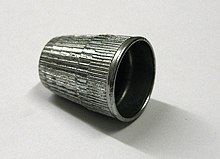Thimble (sewing tool)
The thimble is a mechanical protection against unintentional injury to the fingers when sewing .
history

For the first time thimbles - made of bone or ivory - are documented in the Neolithic near Moscow . The thimble was also used by the Etruscans around 500 BC. In common use. The thimbles came to the area of today's Germany through the Romans . In the 15th century, mass-production began from a preform of brass by the yellow jug . At the time, the strongholds of thimble manufacturing were Cologne and Nuremberg . In the 17th century the production also took place in thimble mills.
Thimbles were made of metal , glass or porcelain in the different epochs . They are collectibles these days. One of the most famous collections comes from the estate of the Gabler brothers in Schorndorf. In 1982 a thimble museum was opened in Creglingen . Here you can see thimbles of all kinds and other sewing utensils of the "thimble guild".
The shape of the thimble gave the plant genus of the same name Digitalis (from Latin digitus "finger") its name.
Shapes, sizes, ways of carrying
Most thimbles are provided with small "dimples" that allow the sewing needle to be supported on the thimble in a non-slip manner. They are made in different sizes depending on the thickness of the fingers of the working hand. Thimbles can have the shape of a cup (see illustration) as well as the shape of a tube open on both sides, they are then called a “ring” or “sewing ring”. They are generally worn on the middle finger of the working hand. In contrast to the thimble, which when working requires letting go of the needle and pressing down with the middle finger, after which it is necessary to grip the needle again, the sewing ring allows continuous movement, because the needle is guided with the thumb and forefinger while at the same time, pressure is exerted on the eye with the middle finger, causing the needle to slide through the fabric. Compared to the thimble, the sewing ring allows a stitch sequence that is three times faster.
Other uses of thimbles
In the music of the skiffle , thimbles (usually worn on all fingers) are used to operate percussion instruments. The washboard in particular can be operated very effectively with thimbles by hitting and rubbing.
In the case of stringed instruments, the use of thimbles can expand the limitation of the tones caused by a certain number of possible tones on the fingerboard. A representative of this technique is for example the lead guitarist of the band Guns N 'Roses Ron "Bumblefoot" Thal.
See also
Web links
- Thimble museum
- Friends of the thimble e. V.
- Biendorf Castle # Private museum “Van de Merwe” with approx. 75,000 exhibits
Individual evidence
- ↑ Adalbert Ruschel: The craft cemetery Sankt Rochus zu Nürnberg: What epitaphs can tell. 2015, ISBN 978-3-7357-0786-4 , p. 174.


